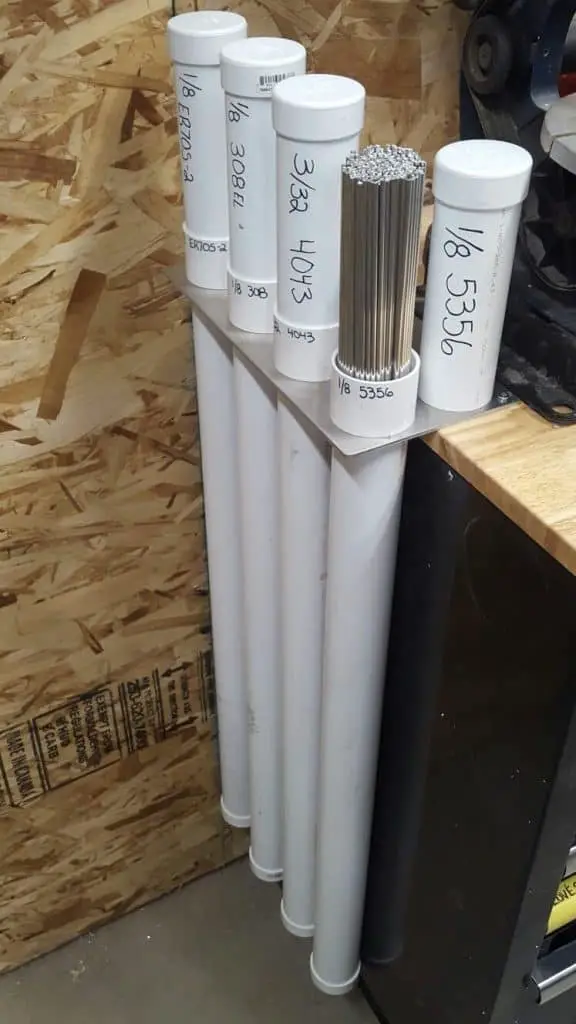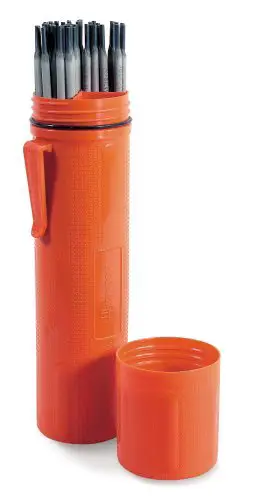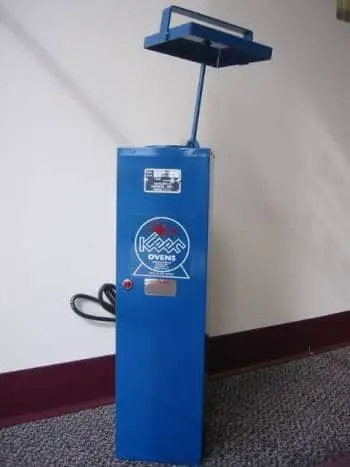This post contains affiliate links to products, services, or education. We may receive a commission for purchases made through links.
Welding is an entertaining hobby, as well as an impressive profession for those who yearn to create. But after the sparks have flown and the welding has been achieved, the welding rods, otherwise known as electrodes, must be properly stowed and put away. But what goes into storing these heat holding metals?
How do you store welding rods? Welding rods must be stored in a dry place with a consistently hot temperature. The type of electrode you store and its manufacturer will determine how hot the temperature of the storage must be as well as how much humidity it can take before becoming unusable.

Welding rods have very specific needs to be met when it comes to storage, and their structure has a lot to do with it. This article will discuss how the factors of temperature and moisture come into play when storing rods as well as go over the incorrect ways to store these sensitive pieces of equipment.
Storage Options
Storing your welding rods correctly will involve a container that both manages the heat that is put on the electrodes, and the amount of moisture allowed to come into contact with the welding rods. The heat should keep the electrodes from absorbing too much moisture in the air.
* If the welding rods are still unopened, then they do not need to be stored because they are already protected from moisture.
We’ve done some extensive research and testing to find the best storage options for a wide variety of rods. Check out our recommended storage options here.
Rod Ovens
Rod ovens are ideal for storing large amounts of welding rods. Some rod ovens have a built-in thermostat that can adjust the temperature if the temperature outside of the oven influences the temperature inside the oven. They are good for keeping the temperature consistent and the rods dry; however, they are not the most cost-effective solution, costing anywhere between $100 and $10,000.

There are many different kinds of rod ovens that can suit all of your electrode needs and storage specifications:
- Portable Welding Electrode Ovens- are on the cheaper end of the spectrum coming in at around $100-$2000. Their size is perfect for those who travel often and want to take their welding tools with them. It is also ideal for those who want some professional storage but not too much room taken up in the process.
- Bench electrode ovens- are much larger than portable electrode ovens, but they are not huge. They are about the size of a mini fridge and are around $1000 in price. Their space is for that of medium inventory, and they are a more permanent installment to the workshop.
- Welding flux ovens- are the grandest and largest of the welding ovens. They are state of the art and will undoubtedly keep your welding rods in tip-top shape. They can range from $1,000-$10,000 in price. They are quite the installment, perfect for larger businesses and workshops, and they can hold an incredible amount of welding rods.
When storing welding rods in a rod oven, it is important to be in and out as fast as possible. The longer the doors are open, the better the chance of your welding rods getting humidity damaged. The hot air will rush out, and the humidity will rush in, so every interaction with the rod oven should happen quickly.
Rod ovens are made more for those who have a code to stick to, such as professional industries and businesses. They aren’t for everyone and are certainly not required to continue welding; they simply assist in long term storage and high quality welds. The ovens help prevent damage to the rods, which prevents damage to the welds they create (which can in turn, help prevent injury to you or others) (which can in turn, help prevent injury to you or others).
Unopened Lincoln Hermetically Sealed Containers
These containers are good for holding smaller amounts of welding rods. They keep out humidity and a bit better on price, but once they are opened, they must be stored in a cabinet that has a temperature between 250º-300ºF.
Dry Boxes For Insensitive Welding Rods

Welding rods can be quite sensitive when it comes to moisture in the air and water in general; however, there are a few welding rods that are actually okay to be stored in their sealed dry containers in room temperature conditions because of their lack of sensitivity to moisture. They won’t last for as long as they could have in an oven, but they will last a little while.
Insensitive welding rods can be stored in pretty much anything that is airtight and dry. A resealable plastic bag, for example, can be used for a short time, as long as it doesn’t break. I don’t recommend it, but in a pinch, it will work.
E-XX10, E-XX11, E-XX12, & E-XX13 can be stored in dry boxes, but see more about that below.

Precautions to Take During Storage
To ensure that the welding rods are not damaged during their period in storage, try to place them in an upright position or in a single row, to prevent the rods from knocking against one another and causing cracks, abrasions, bends, breaks, and other contact damage that may occur. (This is especially important with travel rod ovens and tightly sealed containers storage methods).
Factors in Storage
There are different elements at play when you store welding rods, and they can impact the effectiveness and lifespan of the welding rod. When the elements go out of balance, and your welding rod is left exposed, there may be no coming back from the damage.
Welding Rods and Humidity
Welding rods cannot withstand humidity. They generally will not perform well, if at all, if they are wet. Wet welding rods can cause cracking in the surface of the welding rod and a lot of slag fluidity in the actual weld that is challenging to eliminate. Often the product of a wet welding rod is a weld surface that is rough or cracked.
Damp rods can no longer weld effectively because they will cause hydrogen embrittlement in the weld. Hydrogen embrittlement will cause cracking in the weld, especially if the psi is 80,000 or higher. The harder metals are more brittle in general, and when a wet welding rod comes into contact with this metal, it will make it even more brittle, causing it to crack easily.
In more meticulous welding scenarios that involve low hydrogen welding rods, shops will only provide the amount of welding rod needed to complete the weld, to prevent waste. The thinking behind this is, if the rod is to absorb moisture and become ineffective in the end, then little as possible should be left behind after the welding process is finished.
Low hydrogen welding rods, in particular, must be kept dry and out of the humid air. The 7018 welding rod is one of the lowest hydrogen welding rods and is infamous for its low tolerance to moisture. The coating put on this rod to prevent it from taking on water during its manufacturing is the reason why it takes in so much water when it is taken out of its package.
Low hydrogen welding rods are ideal for technical and structure welding jobs and contain the least amount of hydrogen in their coating, which allows them to make fluid and durable welds. There is a way to prepare them before use to minimize the amount of hydrogen absorbed by the welding rod by coating it in a layer of titania.
Welding Rods and Temperature
The temperature of the area surrounding the welding rod can greatly impact its usefulness. The surroundings of the welding rods must be hot so that any moisture in the air is evaporated. Colder temperatures in the air can breed dampness, and that gives your welding rods a greater chance of having water damage.
Each welding type of welding rod has its own temperature to maintain, determined by its structure and moisture intake. Typically, the rods that are most prone to water absorption are kept at the highest temperatures so that any moisture in the air is more aggressively kept at bay.
Types of Welding Rods
Types of welding rods are dependent upon the code, otherwise known as an AWS (American Welding Society) classification code. At its most fundamental level, it is a 4-digit code on every welding rod indicating its coat, structure, and the angle it welds best at.
There is typically the letter “E” before the numbers begin, which simply means that the welding rod is a “currently carrying electrode.”
The first two digits of the code represent the tensile strength. For instance, if the code is E-6010, the corresponding tensile strength would be a 60,000 psi minimum.
The third digit represents what position you can weld at with the given welding rod:
- Stands for all angles and positions are okay to weld from
- Stands for only flat and horizontal positions will work while welding
- Stands for only flat positions will work while welding
The fourth digit can have many different meanings. It represents the electrical current that should be used with the welding rod as well as the components of the flux, the materials used in the making of the rod:
- Means that the coating and current are indicated by the third digit
- Represents a cellulose potassium coating and a welding current of AC, DCRP, and DCSP
- Represents a titania sodium coating and a welding current of AC and DCSP
- Represents a titania potassium coating and a welding current of AC, DCRP, and DCSP
- Represents an iron powder titania coating and a welding current of AC, DCRP, and DCSP
- Represents a low hydrogen sodium coating and a welding current of only DCRP
- Represents a low hydrogen potassium coating and a welding current of AC and DCRP
- Represents an iron powder iron dioxide coating and a welding current of AC and DCSP
- Represents an iron powder low hydrogen coating and a welding current of AC, DCRP, and DCSP
*Welding rods with the last two digits being 10, 11, 12, and 13 can withstand being stored in a sealed dry container at room temperature.
Since water is an issue with welding rods, there are a few types of rods that have an AWS classification code ending in an “R” suffix. The “R” indicates that there is a type of coating on the electrode that slows the amount of water taken in by the welding rod. The water-resistant coated welding rods can be left out of storage for up to nine hours.
*If the “R” suffix is on a low hydrogen welding rod, you should still place it into storage immediately after use since it is still very prone to humidity damage regardless of the coating. These cannot lie out for nine hours like the non-low hydrogen welding rods; otherwise, they will suffer damage.
It is important to pay attention to the AWS classification code because it can dictate how strictly you store your rods and how long they can last outside of storage. The code indicates the sensitivity of the rod.
Consumable vs. Nonconsumable Welding Rods
Another category that welding rods can be separated into is consumable and non-consumable welding rods.
Consumable welding rods melt during the welding process, or simply break down, which eats up the rod itself until there is no more rod left for welding. These welding rods require more frequent replacement since the rod is typically used as a binding agent itself, or it burns away.
Nonconsumable welding rods do not burn up or join the weld; instead, they heat up the two materials being joined until the materials begin to melt and mix with one another, which ends up joining the two. The rod is still fully intact after the welding process and can be stored and used for another weld in the future.
Signs of Moisture and Damage
When welding rods come into contact with water, they can become porous both internally and externally. It is impossible to detect porosity within your welding rod without an x-ray’s assistance, but the signs of the damage will appear in your welding.
The welding you do will often crack as a result of the damaged welding rod, and the weld bead will look erratic, inconsistent, or incorrect.
The only time porosity will present itself on the electrode, visible to the naked eye, is if it is external. External porosity also indicates internal porosity, and external porosity only appears when the welding rod (typically in a low hydrogen category) has been exposed to a large quantity of water.
Moisture is not the only threat to welding rods. Heat can also occur by way of overheating and reheating constantly. It is not recommended that you redry a welding rod more than three times because too much high intensity heat exposure can cause your coating to “burn up” which will manifest itself as a chipping, cracked, and brittle welding rod.
Redrying Welding Rods
Sometimes having your welding rods exposed to moisture is inevitable, but there is a way to save your equipment. There is a method known as redrying, which can rescue welding rods from their watery graves. It is a process that uses heat to remove water from the welding rod before any terminal damage occurs.
Heating
The best way to eliminate water from a welding rod is by evaporating it. There are two separate methods of doing this though, one is specific to contact with a large amount of water, and the other is specific to less serious exposure to water (such as leaving it out in the air for some time). Low hydrogen and non-low hydrogen electrodes also dry at different temperatures and for different periods of time:
For low hydrogen welding rods, if they have made direct contact with water or have been exposed to air with high humidity, then a method called pre-drying is in order. The rods should be placed in the rod oven at a temperature of 180-220 degrees (Fahrenheit) for one to two hours, and then they can dry properly at their normal temperature for one hour.
For low hydrogen welding rods that were simply left out in the air for too long, you can simply skip the pre-drying method and heat the rods for one hour at their manufacturer’s specified temperature.
For welding rods that are not of the low hydrogen variety, the pre-drying of the welding rods should be set at a temperature of 200-230 (Fahrenheit) degrees for 30 to 45 minutes, if they have come into contact with a large amount of water. Then you can dry them for an hour at their usual temperature.
If the non-low hydrogen welding rods have been left out for too long, then you can dry them at their usual temperature.
- Pre drying is a method that can prevent the coating from cracking or flaking off as a result of oxidation of the alloys. Pre drying for too long can also cause damage to the covering of a welding rod, so be careful not to go overboard.
- Drying any welding rod higher than its intended temperature can cause the welding rods to break during welding and can also cause the covering to crumble and leave a residue.
- When predrying and redrying, laying out the welding rods in a single layer will produce the best outcome. Making sure that none of the welding rods are covered by others will ensure a thorough drying and with that a perfect restoration of the rod and its future welds.
Avoid Temptation
When considering redrying your welding rods, you may have the urge to stick them in the kitchen oven and “bake” the water out of them. Resist the urge. The temperatures that need to be reached in order to properly evaporate all of the water out of your welding rods will be too much for your oven to handle. Your kitchen will most certainly be on fire.
Too Far Gone
Sometimes there is nothing that you can do to restore your welding rod to its former glory. When rods are spent, there is no way of bringing them back, and it is best to just replace them. Some indicators can tell you whether or not it is time to safely discard of a welding rod:
- If the welding rod is cracked, that is a clear sign that the welding rod will not perform well, and there is no undoing the damage.
- If the flux is crumbling or flaking off the welding rod, the welding capabilities of the rod will be severely flawed and may even go out entirely.
- If the welding process is particularly noisy and there is a ton of spatter, then there is no redrying the welding rod (this typically occurs with non-low hydrogen electrodes).
- If there is rust on the welding rod, it is best to replace the rod because it is unlikely that it will perform at all.
- If there are blisters or notable imperfections in the coating, then the welding rod will not weld correctly, and there is no correction to this issue.
Welds are often of great importance, but if you want a weld to come out particularly flawless, it is best to start with a clean, fresh rod rather than an old one that has potentially suffered some consequential damage.
If you determine that welding rod is past the point of no return, and you want to throw it away, you can dispose of it in a red skip tub to prevent any accidental injuries and take a collection of spent welding rods to a scrap metal yard and/or recycle it for some quick cash.
Incorrect Methods of Storage
To cut down on costs, you may hear some rumors of the refrigerator and the oven storage hacks, but these are not sustainable methods of storage and can have dangerous consequences.
A Lightbulb and a Refrigerator
This highly shared technique for storing welding rods may at first seem convenient but is cautioned against by welding professionals. The idea is that an old refrigerator (an insulated container) can be taken and fitted to have a 100-150 watt bulb placed inside of it. With the insulation and the heat of the light bulb, it sounds like the perfect container for welding rods.
As it would turn out, a 100 watt light bulb cannot possibly generate enough heat to maintain a hot enough environment for your welding rods. Moreover, the heating in the fridge may not be consistent throughout the space, causing multiple welding rods to become humidity damaged.
(There is also a chance that someone, mainly a child, could manage to get stuck inside the fridge if they were to crawl inside, so it can be dangerous to keep in neutral spaces).
Household Ovens
At first, the oven may seem like the perfect place to store your welding rods. It can hold heat at a constant temperature, it is well insulated, and it can reach some higher temperatures with certainty. But it is not safe.
If the kitchen oven were to work as a rod oven, it would typically have to be running at temperatures around 400 degrees (some welding rods even need a holding temperature of 750 degrees) and for long periods of time. This is a disaster waiting to happen as an explosion or fire could occur because ovens were not built to hold extremely high temperatures for hours on end.
The Freezer
It is believed that you can keep moisture off of welding rods if you wrap them wrapped in a plastic bag and store them in the freezer. The bag is supposed to keep out any water while the cold air prevents humidity. But the opposite occurs.
When the bag is placed in the freezer, the cold air meeting the warmer temperature of the bag will cause the inside of the bag to condensate. AKA, it will rain on your welding rods. This, of course, is the opposite of the desired outcome, and your rods will come out cracked, flaking, and possibly rusted depending on how long you leave them in the freezer.
DIY Methods of Storage that Work Could Work
If you are welding for yourself and are not particularly concerned with being “up to code,” then chances are that you may not sweat the small stuff.
Rod ovens and Lincoln Hermetically sealed containers are good for professional small and large businesses with the cost of the storage fitting the demands of space needed for all of the electrodes and expectations of perfectly welded materials.
In order to build a storage container that gives the proper support to the welding rods, you need to make sure that it has all of the proper qualities such as:
- A consistent and adjustable temperature that can safely reach up to 800 degrees
- Good insulation
- Able to keep a consistent temperature throughout the entire component
- Ventilation – for the moisture to escape
Although there is no guarantee that the project will keep your welding rods 100% dry, replicating a rod oven as closely as possible might work to your advantage in the end, just at a lower cost. All that you would have to do is make sure that the points above are thought through.
It might also help to maybe give your creation a test before putting all of your welding rods into the newly invented oven. See how the rods react for a few days and, based on those results, take action from there.


